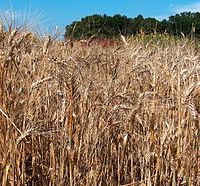
Photo from wikipedia
BACKGROUND Durum wheat is key source of calories and nutrients for many regions of the world with a future demand predicted to increase; consequently, further efforts are needed to develop… Click to show full abstract
BACKGROUND Durum wheat is key source of calories and nutrients for many regions of the world with a future demand predicted to increase; consequently, further efforts are needed to develop new cultivars adapted to different future scenarios. Developing a novel cultivar takes, in average, ten years and during the process advanced lines are tested, in general, under standardized conditions. Although that evaluating candidate genotypes for commercial release under different on-farm conditions is a highly recommended strategy, limited is the application in durum wheat and particularly for quality traits. This study evaluated the grain yield and quality performance of eight different genotypes across five contrasting farmer's field over two seasons. Combining different analysis strategies, we identified the most outstanding and stable genotypes. RESULTS The analyses revealed that some traits were mainly explained by the genotype effect (thousand kernel weight, flour SDS-sedimentation volume and flour yellowness), others by the management practices (yield and grain protein content) and others (test weight) by the year effect. In general, yield showed the highest range of variation across genotypes, management practices and years while test weight the narrowest one. Flour yellowness was the most stable trait across management conditions, while yield-related traits were the most unstable. In addition, we determined the most representative and discriminative field conditions, which is a beneficial strategy when breeders are constrained in their ability to develop multi-environment experiments. CONCLUSIONS We concluded that assessing genotypes in different farming systems is a valid and complementary strategy to on-station trials for determining the performance of future commercial cultivars in heterogeneous environments in order to improve the breeding process and resources. This article is protected by copyright. All rights reserved.
Journal Title: Journal of the science of food and agriculture
Year Published: 2023
Link to full text (if available)
Share on Social Media: Sign Up to like & get
recommendations!